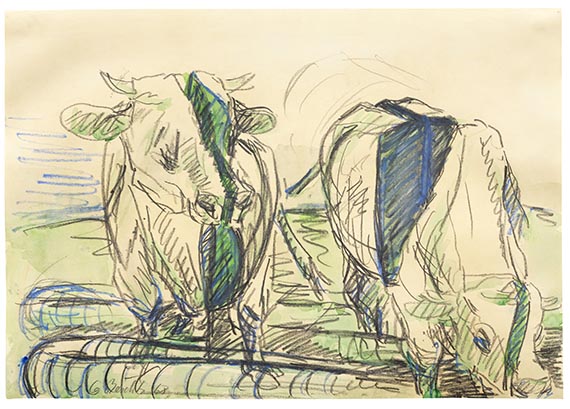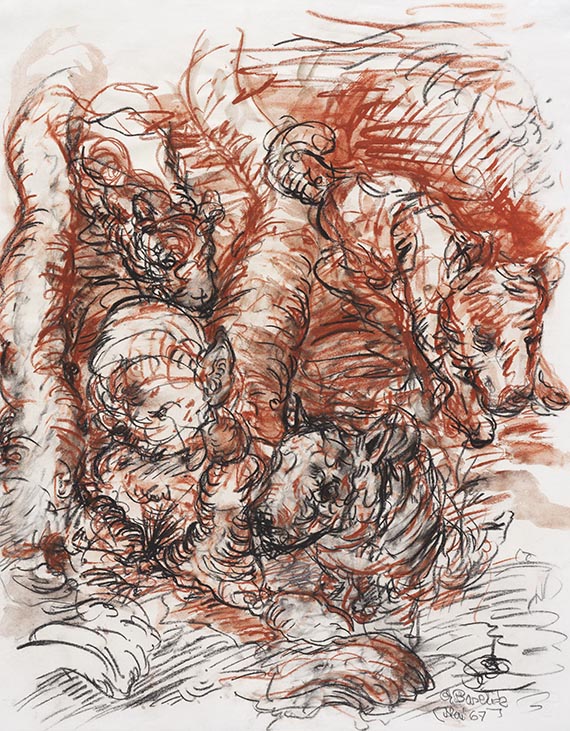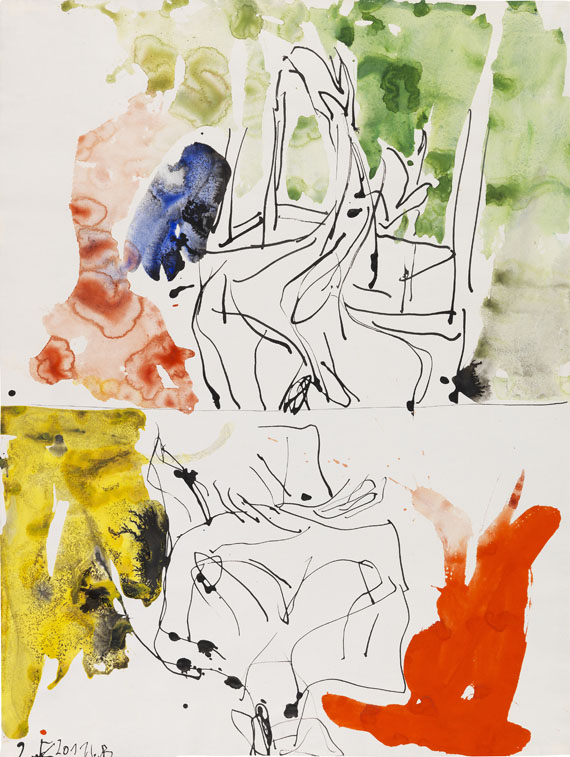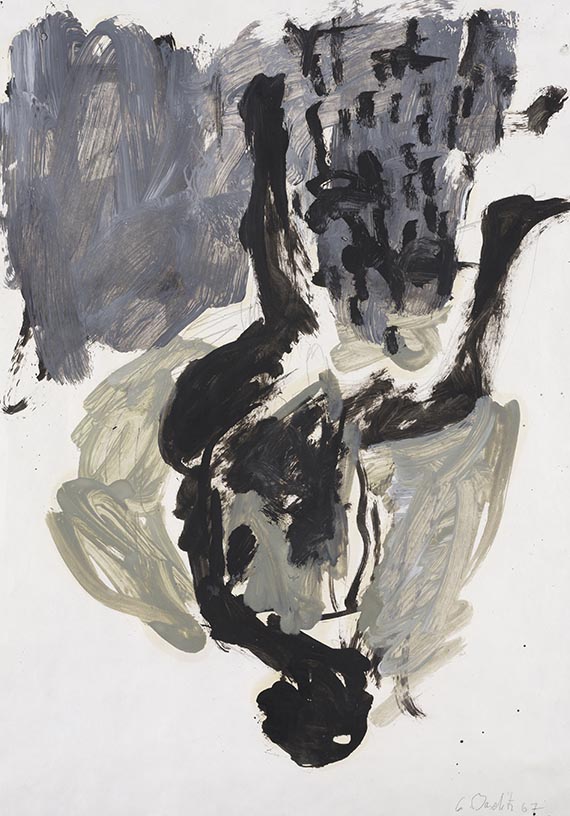198
Georg Baselitz
Zwei Kühe, 1968.
Watercolor and pastel chalks
Prezzo di vendita dopo asta: € 30,000 / $ 35,400
Zwei Kühe. 1968.
Watercolor and pastel chalks.
Signed and dated in the lower left. Signed, dated and titled on the reverse. On off-white laid paper. 35.1 x 50.1 cm (13.8 x 19.7 in), size of sheet. [JS].
• This work is from Baselitz's bold early body of work from the 1960s, which includes the famous “Hero” and “Fraktur” paintings.
• An exceptionally colorful work on paper, created in the context of Baselitz's rebellious “Fraktur” painting “Zwei halbe Kühe” (Two Half Cows, 1968).
• This work, as well as his first “upside-down” painting “Der Wald auf dem Kopf” from 1969), reveals progressive pictorial ideas that engage with art historical tradition.
• Baselitz attempts to disrupt the subject matter through his fragmented painting style and to confuse our traditional viewing habits as much as possible..
We are grateful to the Georg Baselitz Archive, Munich, for the kind expert advice. The work is registered in the archive of the artist's works.
PROVENANCE: Private collection, South Germany.
EXHIBITION: Siegfried Gnichwitz (ed.), Kunst geht in die Farbik. Dokumentation eines Experiments, Bonn-Bad Godesberg, Wissenschaftszentrum des Stifterverbandes für die Deutsche Wissenschaft, May-June 1987, p. 128 (illustrated).
"I love how art historians analyze Cranach, Correggio, and so on, but as a painter, I've never been particularly interested in that. I draw my inspiration from elsewhere, especially from the boldness exhibited by certain painters. The audacity to change images, to recreate them."
Georg Baselitz, quoted from: https://artinwords.de/wien-khm-georg-baselitz/
Watercolor and pastel chalks.
Signed and dated in the lower left. Signed, dated and titled on the reverse. On off-white laid paper. 35.1 x 50.1 cm (13.8 x 19.7 in), size of sheet. [JS].
• This work is from Baselitz's bold early body of work from the 1960s, which includes the famous “Hero” and “Fraktur” paintings.
• An exceptionally colorful work on paper, created in the context of Baselitz's rebellious “Fraktur” painting “Zwei halbe Kühe” (Two Half Cows, 1968).
• This work, as well as his first “upside-down” painting “Der Wald auf dem Kopf” from 1969), reveals progressive pictorial ideas that engage with art historical tradition.
• Baselitz attempts to disrupt the subject matter through his fragmented painting style and to confuse our traditional viewing habits as much as possible..
We are grateful to the Georg Baselitz Archive, Munich, for the kind expert advice. The work is registered in the archive of the artist's works.
PROVENANCE: Private collection, South Germany.
EXHIBITION: Siegfried Gnichwitz (ed.), Kunst geht in die Farbik. Dokumentation eines Experiments, Bonn-Bad Godesberg, Wissenschaftszentrum des Stifterverbandes für die Deutsche Wissenschaft, May-June 1987, p. 128 (illustrated).
"I love how art historians analyze Cranach, Correggio, and so on, but as a painter, I've never been particularly interested in that. I draw my inspiration from elsewhere, especially from the boldness exhibited by certain painters. The audacity to change images, to recreate them."
Georg Baselitz, quoted from: https://artinwords.de/wien-khm-georg-baselitz/
His outstanding artistic work, which has repeatedly found new creative ways to challenge and perpetuate art historical traditions since the 1960s, has made Georg Baselitz one of the most famous figures in contemporary German art. With his influential figurative works, he defies established categories and repeatedly challenges our traditional perception of art. In 1963, Baselitz rose to fame overnight with a significant controversy. His paintings “Die große Nacht im Eimer” (The Great Night in the Bucket, 1962) and “Der nackte Mann” (The Naked Man, 1962), shown in a solo exhibition at the Werner & Katz Gallery in Berlin, caused a major scandal. The latter depicts an emaciated male nude lying dead in a grave-like hole with an oversized penis. A shocking painting that alludes both to depictions of Christ's corpse and to images from Nazi concentration camps, which were ignored by large parts of German society after the war. Both paintings were confiscated by the public prosecutor's office on charges of pornography. The following day, the BZ newspaper wrote: “This is a scandal the likes of which Berlin has not seen since the end of the war.” In his famous “Hero” paintings (1965/66), in which Baselitz stages physically and emotionally broken figures, the rebellious artist confronts post-war German society just as relentlessly with its painful past. In the late 1960s, these antiheroes were followed by the “Fraktur” paintings (1966–1968), which also contain an inherent destructive element, as they visually dismantle the subject. Our colorful paper work was created in the context of the painting “Zwei halbe Kühe” (Two Half Cows, 1968), which Ketterer Kunst sold with great success from the same southern German private collection in 2017. With energetic strokes, Baselitz captured the two animals' shapes, which are partly broken down into contrasting areas of color. Shortly after this critical early creative phase, Baselitz produced his first upside-down painting, “Der Wald auf dem Kopf” (The Forest on the Head, Museum Ludwig, Cologne), in 1969. Once again, Baselitz radically challenged our traditional viewing habits. This step, which would become Baselitz's artistic trademark, was another powerful act of painterly liberation. “The act of painting itself emancipates itself from representation, from the pictorial, and at the same time allows the works to appear representational and non-representational.” (Toni Stoss, in: Georg Baselitz, Gemälde und Skulpturen 1960-2008, p. 8). [JS]
198
Georg Baselitz
Zwei Kühe, 1968.
Watercolor and pastel chalks
Prezzo di vendita dopo asta: € 30,000 / $ 35,400
Commissione, tassa e diritti di seguito
Quest'oggetto viene offerto con regime fiscale normale o con imposizione sul margine di profitto.
Calcolo commissione particolare sul margine del profitto:
- Prezzo d’aggiudicazione fino a 800.000 euro: provvigione del 32%.
- Per la parte del prezzo d’aggiudicazione superiore a 800.000 euro si calcola una provvigione del 27%, che viene aggiunta a quella relativa alla parte del prezzo d’aggiudicazione fino a 800.000 euro.
- Per la parte del prezzo d’aggiudicazione superiore a 4.000.000 euro si calcola una provvigione del 22%, che viene aggiunta a quella relativa alla parte del prezzo d’aggiudicazione fino a 4.000.000 euro.
La provvigione comprende l'IVA, ma questa non viene indicata.
Calcolo regime fiscale normale:
Prezzo di aggiudicazione fino a 800.000 €: supplemento del 27%.
Prezzo di aggiudicazione superiore a 800.000 €: Parte del prezzo fino a 800.000 € supplemento del 27 %, parte del prezzo che supera i 800.000 € supplemento del 21%.
Prezzo di aggiudicazione superiore a 4.000.000 €: Parte del prezzo che supera i 4.000.000 € supplemento del 15%.
L'IVA prevista dalla legge è pari al 7 % sulla somma del prezzo di aggiudicazione e del supplemento.
La preghiamo di avvisarci prima della fatturazione nel caso in cui desidera applicare il regime fiscale normale.
Calcolo diritti di seguito:
Per le opere originali di arti figurative e fotografie di artisti viventi o deceduti da meno di 70 anni soggette al diritto di seguito, in tutti i casi suddetti viene riscossa in aggiunta, a liquidazione della compensazione del diritto di seguito dovuto dalla casa d'aste ai sensi del § 26 della legge tedesca sul diritto d'autore (Urheberrechtsgesetz, UrhG), una compensazione del diritto di seguito con le percentuali indicate nel § 26 2° comma UrhG, che attualmente sono le seguenti:
4 per cento della parte del ricavo della vendita da 400,00 euro a 50.000 euro,
un altro 3 per cento della parte del ricavo della vendita da 50.000,01 a 200.000 Euro,
un altro 1 per cento della parte del ricavo della vendita da 200.000,01 a 350.000 Euro,
un altro 0,5 per cento della parte del ricavo della vendita da 350.000,01 a 500.000 euro e
un altro 0,25 per cento della parte del ricavo della vendita superiore a 500.000 euro.
L’importo complessivo della compensazione del diritto di seguito derivante da una rivendita è pari al massimo a 12.500 euro.
Calcolo commissione particolare sul margine del profitto:
- Prezzo d’aggiudicazione fino a 800.000 euro: provvigione del 32%.
- Per la parte del prezzo d’aggiudicazione superiore a 800.000 euro si calcola una provvigione del 27%, che viene aggiunta a quella relativa alla parte del prezzo d’aggiudicazione fino a 800.000 euro.
- Per la parte del prezzo d’aggiudicazione superiore a 4.000.000 euro si calcola una provvigione del 22%, che viene aggiunta a quella relativa alla parte del prezzo d’aggiudicazione fino a 4.000.000 euro.
La provvigione comprende l'IVA, ma questa non viene indicata.
Calcolo regime fiscale normale:
Prezzo di aggiudicazione fino a 800.000 €: supplemento del 27%.
Prezzo di aggiudicazione superiore a 800.000 €: Parte del prezzo fino a 800.000 € supplemento del 27 %, parte del prezzo che supera i 800.000 € supplemento del 21%.
Prezzo di aggiudicazione superiore a 4.000.000 €: Parte del prezzo che supera i 4.000.000 € supplemento del 15%.
L'IVA prevista dalla legge è pari al 7 % sulla somma del prezzo di aggiudicazione e del supplemento.
La preghiamo di avvisarci prima della fatturazione nel caso in cui desidera applicare il regime fiscale normale.
Calcolo diritti di seguito:
Per le opere originali di arti figurative e fotografie di artisti viventi o deceduti da meno di 70 anni soggette al diritto di seguito, in tutti i casi suddetti viene riscossa in aggiunta, a liquidazione della compensazione del diritto di seguito dovuto dalla casa d'aste ai sensi del § 26 della legge tedesca sul diritto d'autore (Urheberrechtsgesetz, UrhG), una compensazione del diritto di seguito con le percentuali indicate nel § 26 2° comma UrhG, che attualmente sono le seguenti:
4 per cento della parte del ricavo della vendita da 400,00 euro a 50.000 euro,
un altro 3 per cento della parte del ricavo della vendita da 50.000,01 a 200.000 Euro,
un altro 1 per cento della parte del ricavo della vendita da 200.000,01 a 350.000 Euro,
un altro 0,5 per cento della parte del ricavo della vendita da 350.000,01 a 500.000 euro e
un altro 0,25 per cento della parte del ricavo della vendita superiore a 500.000 euro.
L’importo complessivo della compensazione del diritto di seguito derivante da una rivendita è pari al massimo a 12.500 euro.




 Lot 198
Lot 198 


